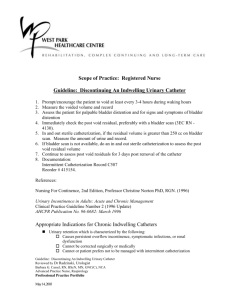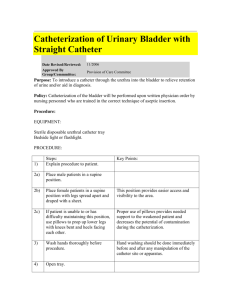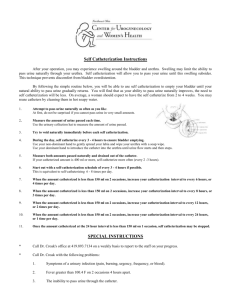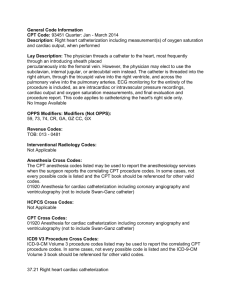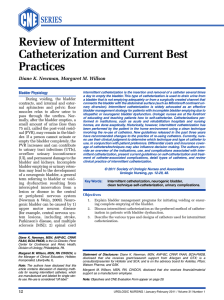Sterile Intermittent Catheterization Policy ()
advertisement
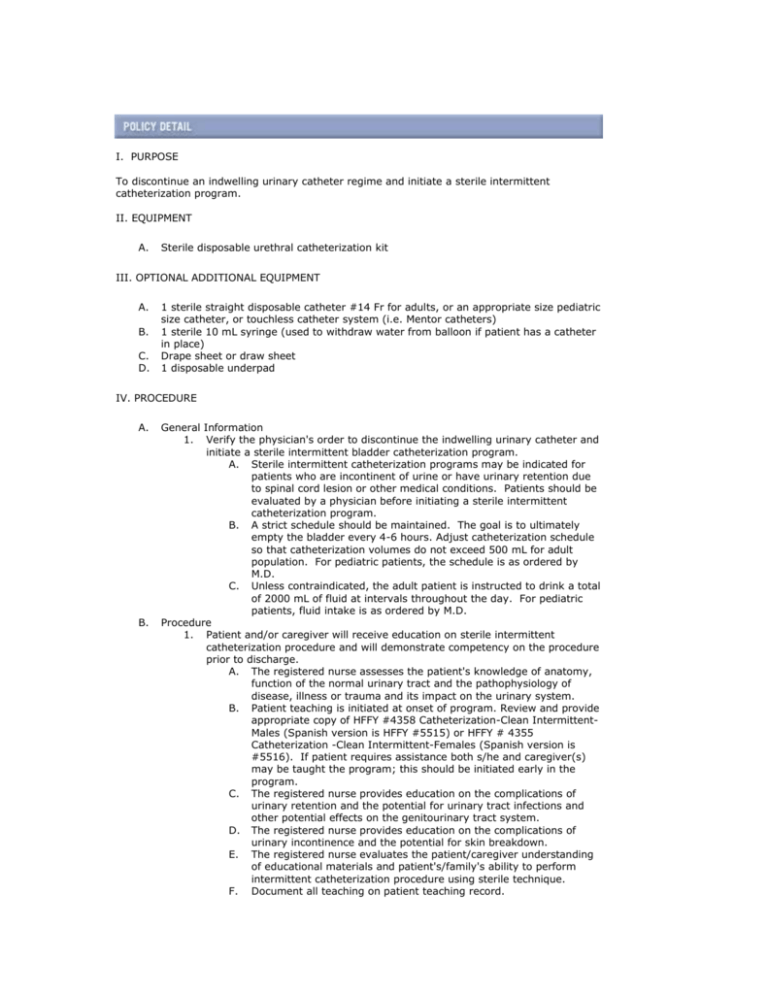
I. PURPOSE To discontinue an indwelling urinary catheter regime and initiate a sterile intermittent catheterization program. II. EQUIPMENT A. Sterile disposable urethral catheterization kit III. OPTIONAL ADDITIONAL EQUIPMENT A. B. C. D. 1 sterile straight disposable catheter #14 Fr for adults, or an appropriate size pediatric size catheter, or touchless catheter system (i.e. Mentor catheters) 1 sterile 10 mL syringe (used to withdraw water from balloon if patient has a catheter in place) Drape sheet or draw sheet 1 disposable underpad IV. PROCEDURE A. B. General Information 1. Verify the physician's order to discontinue the indwelling urinary catheter and initiate a sterile intermittent bladder catheterization program. A. Sterile intermittent catheterization programs may be indicated for patients who are incontinent of urine or have urinary retention due to spinal cord lesion or other medical conditions. Patients should be evaluated by a physician before initiating a sterile intermittent catheterization program. B. A strict schedule should be maintained. The goal is to ultimately empty the bladder every 4-6 hours. Adjust catheterization schedule so that catheterization volumes do not exceed 500 mL for adult population. For pediatric patients, the schedule is as ordered by M.D. C. Unless contraindicated, the adult patient is instructed to drink a total of 2000 mL of fluid at intervals throughout the day. For pediatric patients, fluid intake is as ordered by M.D. Procedure 1. Patient and/or caregiver will receive education on sterile intermittent catheterization procedure and will demonstrate competency on the procedure prior to discharge. A. The registered nurse assesses the patient's knowledge of anatomy, function of the normal urinary tract and the pathophysiology of disease, illness or trauma and its impact on the urinary system. B. Patient teaching is initiated at onset of program. Review and provide appropriate copy of HFFY #4358 Catheterization-Clean IntermittentMales (Spanish version is HFFY #5515) or HFFY # 4355 Catheterization -Clean Intermittent-Females (Spanish version is #5516). If patient requires assistance both s/he and caregiver(s) may be taught the program; this should be initiated early in the program. C. The registered nurse provides education on the complications of urinary retention and the potential for urinary tract infections and other potential effects on the genitourinary tract system. D. The registered nurse provides education on the complications of urinary incontinence and the potential for skin breakdown. E. The registered nurse evaluates the patient/caregiver understanding of educational materials and patient's/family's ability to perform intermittent catheterization procedure using sterile technique. F. Document all teaching on patient teaching record. 2. 3. Sterile intermittent catheterization procedure. A. Assemble equipment; arrange for privacy; adjust bed for comfortable working position. B. An extra catheter and gloves should be taken to the bedside (for use if one becomes contaminated). C. An appropriate size catheter should be used to reduce the possibility of traumatizing the urethra. (Refer to attachment 1 for pediatric sizes). D. If sensation is present, determine need and obtain MD order for anesthetic lubricant. E. Determine if patient is incontinent before starting procedure and do perineal care as indicated. F. Position the patient. Visualization of the urinary meatus is easiest when the female patient is in a dorsal recumbent position with legs widely separated and the knees flexed. A second person may be needed to assist the patient to keep the legs separated. G. Catheterize the patient and collect urine specimen (refer to Nurses' Guide to Clinical Procedures - Nursing procedures: Performing a Male Catheterization or Performing a Female Catheterization). H. Spinal cord injury patients require Crede' technique. Begin Crede' procedures when urine flow stops after catheter insertion. Palpate for the fundus of the bladder. Place fist at the fundus and apply pressure down toward the symphysis pubis. Release pressure, palpate again and repeat this step until all urine is expelled. Record in the patient's clinical record the time procedure was performed, who performed the procedure, characteristics of urine, total volume obtained,how procedure was tolerated by patient, if/how patient participated in procedure, if patient was wet or dry when starting the procedure and if a laboratory specimen was obtained and disposition of same. A. If patient voids, measure urine output. If indicated, scan the bladder to document volume of urine remaining in bladder. If indicated or ordered by MD, perform intermittent catheterization. The total amount obtained by catheterization after a successful voiding attempt is called post void residual (PVR). Record the amount voided and amount of PVR separately. B. Urine residual should not exceed 500 mL for a patient on intermittent catheterization. Catheterization time schedule is adjusted to ensure that the bladder is not over-distended.
